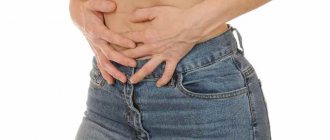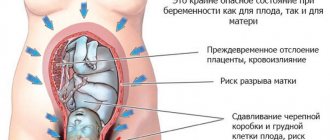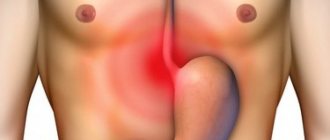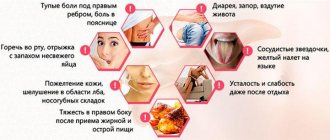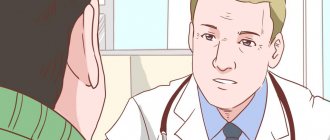Pain in the intestines
Intestinal pain is the most common complaint with intestinal diseases.
It differs from pain in diseases of the stomach in that it has no connection with eating (an exception is the inflammatory process in the transverse colon, in which abdominal pain occurs after eating: pain in the intestines is associated with reflex contractions of the intestine when food enters the stomach). Bowel pain is the most common complaint in bowel diseases
Pain in the intestines can be aching and cramping (intestinal colic). Colicky pain is characterized by short, repeated attacks. The aching pain is persistent and intensifies with strain from coughing. The pain is typical of inflammatory bowel disease. Pain in the intestines can occur as a result of distension of the intestines by gases during flatulence, intestinal obstruction (with tumors, volvulus, nodule formation). Such pains, unlike spastic ones, are more constant and aching in nature.
Often, with intestinal obstruction, pain due to stretching is accompanied by severe cramping pain associated with increased intestinal peristalsis above the obstruction site. With the development of adhesions between the intestinal loops, the pain has a pulling nature, intensifies when lifting a load, depends on the position of the body, and is provoked by an enema.
The localization of pain in intestinal diseases depends on which part of the intestine is affected:
- in diseases of the small intestine, pain is felt in the umbilical region, in acute appendicitis - in the right half of the abdomen, first appearing in the stomach and after a few hours going down.;
- with appendicular colic, pain may radiate to the right leg;
- pain in the right iliac region (the area of the wing of the ilium on the right) occurs with appendicitis, intestinal cancer, inflammation of the intestine (typhlitis);
- in patients with dysentery, intestinal obstruction, inflammation of the sigmoid colon, ulcerative colitis, cancer of the sigmoid and descending colon, pain is noted in the left iliac region;
- with acute damage to the left parts of the colon (dysentery), pain radiates to the sacral region;
- with lesions of the rectum (hemorrhoids, anal fissure, cancer, proctitis - inflammation of the rectum), pain is localized in the perineum, intensifying during the act of defecation, accompanied by a painful false urge to defecate (tenesmus);
- the appearance of pain before defecation is associated with disease of the colon, sigmoid colon, during defecation - with hemorrhoids, anal fissures, cancer;
- pain in the navel area is observed with inflammation of the small intestine (enteritis), inflammation and cancer of the colon;
- with intestinal obstruction, colicky pain is combined with constant pain. They are characterized by a certain localization (navel or colon area) and intensification due to intestinal peristalsis;
- Pain from intestinal damage can radiate to the chest and be mistaken for angina attacks.
Most often, pain in the lower abdomen is caused by gastrointestinal diseases, and each disease is characterized by its own symptoms. However, in some cases, discomfort can be caused by other reasons: urological diseases, STDs, nervous diseases, hematopoietic pathologies, etc. In this case, the person will also feel that it is his intestines that are suffering. Only a doctor can more accurately diagnose the cause of pain.
When the intestines hurt in the lower abdomen, its localization also plays an important role: pain can be felt on the right and left, near the ilium, closer to the navel, or radiate to the entire area of the abdomen.
Depending on its location in the lower abdomen, we can talk about various diseases:
- lower abdomen in the navel area: suspicion may fall on enteritis, colic or worms;
- in the right iliac region: appendicitis, diseases of the cecum;
- on the left side of the ileum: dysentery, NKY, diseases of the sigmoid colon;
- if the pain spreads in the lower abdomen throughout the entire peritoneum: this may mean inflammation of several segments of the intestine or a duodenal ulcer.
You also need to pay attention to the circumstances surrounding painful sensations. If the problem occurs after eating, then the cause must be sought in the large intestine or there are problems with fermentation. When pain in the lower abdomen in the intestines begins after a change in body position or after physical exercise, you need to check for the presence of adhesions. If pain in the intestines appears during the act of defecation, it may be hemorrhoids or neoplasms.
Acute appendicitis
Pain on the right side of the lower abdomen is very typical for such a pathological process as acute appendicitis. This is an inflammatory process of the vermiform appendix of the cecum.
. The following symptoms are characteristic of this disease:
- in 90% of cases the pain appears in the middle of the abdomen;
- after 12 to 24 hours, the pain syndrome moves down the abdomen to the right side;
- pain does not disappear over time, it can only intensify or weaken;
- the increase in pain begins with rapid movement, a cough symptom;
- the pain subsides a little in a supine position, on the side where the lesion is located;
- characteristic, once or twice vomiting;
- intestinal upset in the form of diarrhea occurs rarely;
- body temperature rises to a maximum of 38˚C;
- Shchetkin-Blumberg's symptom is sharply positive.
If at least some of the above symptoms are detected, urgent hospitalization followed by surgical intervention is necessary. If surgical intervention does not occur for some reason, gangrene or rupture of the inflamed appendix may develop.
. The result is purulent peritonitis.
Possible causes of intestinal pain on the right
The causes of abdominal pain on the right can be divided into pathological and non-pathological. The latter include overeating, food poisoning, poor diet, or intense exercise after abdominal surgery. In addition, short-term pain sometimes occurs due to strong psycho-emotional stress, such as stress. Aching pain on the lower right side may appear due to excessive gas formation.
Painful sensations on the right side of the abdominal cavity do not always occur in the intestines. The danger is that it is often difficult to distinguish them. Pathological causes of pain in the right intestine include the following diseases:
- the occurrence of neoplasms;
- Crohn's disease;
- colitis (including ischemic);
- dyskinesia;
- diverticulum;
- inflammation of the appendix;
- tuberculosis;
- dysbacteriosis;
- irritable bowel syndrome;
- nonspecific ulcerative colitis;
- infectious intestinal diseases, etc.
Diverticula
Diverticula are pathological sac-like formations in the intestinal wall. They communicate with the lumen, and as a result, stagnation of intestinal contents occurs there. As a result, the process of inflammation occurs.
If there is pain in the right lower abdomen, Meckel's diverticulum (the final section of the small intestine) may occur. The development of the disease can be observed in the cecum and/or ascending colon.
The symptoms of the disease practically coincide with the symptoms of acute appendicitis:
- the anterior abdominal wall is tense;
- painful sensations when touching the affected area in the intestines;
- positive neurological symptoms.
A distinctive feature is the long course of the disease with attacks of exacerbation: constipation, alternating with digestive disorders.
If, when observing these symptoms, you ignore a visit to the doctor and do not start timely treatment, suppuration, perforation, the formation of fistulas with the subsequent development of peritonitis may occur.
Irritable bowel syndrome or why your stomach hurts
An unpleasant feature of pain in the intestines is that they (unlike pain in the stomach) have practically nothing to do with the timing of meals. In some cases, this fact can confuse a person, since the intestines sometimes hurt quite severely, and attacks happen extremely unexpectedly.
The only exceptions are disturbances in the functioning of the transverse section of the colon - in this case, pain appears immediately after eating due to an increase in the barometric load that comes from the bottom of the stomach. It is much worse when the cause of such pain is various (and sometimes quite serious) diseases.
If there are defects in the functioning of the large intestine, dull bursting pain is felt in the side. The pain is always antispasmodic in nature, that is, it is not constant. There are often cases when, due to intestinal disease, the patient has a fever and a feeling of fatigue. If you experience these symptoms, you should consult a doctor. Today medicine can cure almost any intestinal disease. And in the early stages this will be even easier.
Irritable bowel syndrome (IBS) is a complex of functional digestive disorders in the intestine, not associated with organic damage to the intestine itself, that last for more than three months.
When the intestines in the lower abdomen hurt, an important role is played and its localization, the pain can be felt on the right and left near the ilium closer to the navel or spread over the entire area of the abdomen.
It is believed that a person has irritable bowel syndrome if he is bothered by pain and a feeling of discomfort for a specified time in the stomach (usually decreasing after going to the toilet); flatulence, rumbling; a feeling of incomplete bowel movement or an imperative (urgent) urge to defecate; stool disorders (constipation, diarrhea or alternation of diarrhea with constipation). The cause of pain is intestinal spasms or excessive gas formation with overstretching of its walls.
You can guess if you have irritable bowel syndrome by the following signs:
- pain in the abdomen around the navel or lower abdomen after eating, it usually disappears after bowel movements or passing gas;
- diarrhea after eating, usually in the morning and early afternoon;
- constipation;
- flatulence;
- feeling of incomplete bowel movement after visiting the restroom;
- sometimes - belching of air, nausea, a feeling of heaviness and fullness in the stomach.
It is characteristic that all these unpleasant symptoms arise from excitement or after it, as a result of prolonged physical and nervous stress. Often, intestinal disorders are accompanied by headache, a feeling of a lump in the throat, insomnia, a feeling of lack of air, frequent urination, tinnitus, a feeling of weakness, and dry mouth.
Crohn's disease
Crohn's disease refers to inflammatory diseases of the terminal ileum. Is chronic
. In 20% of cases it is discovered completely by accident (when
surgery is performed to remove the appendix).
The symptoms of the disease are very similar to those of appendicitis. In order to correctly establish the diagnosis, it is necessary to carefully interview the patient
. An acute period of disease in the intestines is often preceded by the following symptoms:
- very long (from 7 days to 2-3 years) period of indigestion;
- there is a tendency to severe digestive upset;
- no vomiting;
- the pain is located exclusively on the right side of the lower abdomen.
If these symptoms are detected, urgent hospitalization followed by surgical treatment is indicated.
How to deal with pain?
It is recommended to lie down for a while if pain in the intestines occurs.
Painful sensations in the right side, lower abdomen or hypochondrium are a reason to consult a doctor, especially if they occur systematically or have been bothering you for a long time. If your intestines start to hurt, you need to lie down for a while. In this case, you should forget about eating, warming up or “cold” therapy.
When the patient consults a doctor, a thorough diagnosis will be carried out, which will help identify the cause of unpleasant feelings in the right side. To do this, the doctor will collect an anamnesis, examine the patient, palpate the abdominal cavity and prescribe the necessary laboratory and instrumental studies. After making a diagnosis, the specialist will prescribe adequate therapeutic procedures.
Before going to the doctor, pain can be relieved with antispasmodics (for example, No-shpa, Drotaverine, etc.). The symptom should disappear in a maximum of half an hour. If you are bothered by bloating, the symptom may be caused by a long-standing bowel movement. To help yourself, you need to drink a sorbent (for example, activated carbon).
Sometimes, in this case, you need to use a product that will help carry out the act of defecation (for example, Microlax microenemas or glycerin suppositories). It is recommended to increase the volume of fluid consumed to 2 liters daily. This will help prevent constipation. For discomfort in the abdominal area to the right of the navel, special physical exercises help, which improve motility and absorption in the organ.
Blockage of the intestinal lumen
The factors that led to this disease may include two reasons: intestinal volvulus and blockage of the intestinal lumen due to the action of foreign bodies.
When intestinal volvulus occurs, the disease develops very quickly, as nerve conduction is disrupted and blood supply to the walls of the intestine is stopped. When the intestinal lumen is blocked by a foreign body, peristalsis is disrupted.
If there is any factor that led to blockage of the lumen in the intestine, there is very severe pain in the abdominal area, which radiates to the right iliac region. An unpleasant feeling is usually accompanied by vomiting (in 95% of cases after eating), peristalsis is not observed.
When should you call a doctor?
https://www.youtube.com/watch?v=-47qizLC82o
If pain and intestinal colic do not go away half an hour after drinking an antispasmodic (provided you lie quietly), it is most likely necessary to call an ambulance, since only a doctor can tell why the pain does not subside. It is mandatory to call an ambulance if you have the following symptoms:
- the pain is sharp and very strong;
- constant vomiting;
- significant increase in temperature indicators.
It is important not to delay calling an ambulance. The sooner the doctor diagnoses and determines the cause of pain to the right of the navel, the sooner treatment will be prescribed. Early detection of the disease makes treatment more effective. In addition, this will help prevent possible complications of diseases. The treatment for each disease is specific, so you should not delay calling a doctor and self-medicate.
Tumor processes
Among a large number of neoplasms, pain in the right lower abdomen occurs due to benign processes (intestinal polyps) or malignant formations (colon cancer).
If a tumor process is just beginning to develop in the body, it does not hurt much. The pain is not clearly localized. With further development of the disease, polyps or tumors block the intestinal lumen
. This will lead to obstruction.
In addition to pain in the right lower abdomen, the following symptoms may also bother you when tumors develop:
- constipation;
- an admixture of blood appears in the stool;
- unjustified weakness and fatigue;
- sudden weight loss and loss of appetite.
At the slightest suspicion of a tumor process, you should immediately consult a doctor.
Diseases of the small and large intestines
The small intestine plays an important role in digesting food. It undergoes final processes, as a result of which food is broken down into relatively simple substances. When the small intestine malfunctions, the body does not fully receive the substances it needs. The main principle of operation and task of the colon is to push food, through spasms, further into the rectum. These spasms are not felt because they are a reflex movement of the body.
Dyskinesia is a disease that impairs intestinal motor function. As a result, the functioning of the gastrointestinal tract is disrupted. In this case, infections, ulcers, and unnatural formations in the intestine do not occur. Diverticula is a sac-shaped formation on the intestinal walls measuring 1-2 centimeters. When pressure increases in the esophagus, in weak areas the mucous membrane is pushed into the gaps between the muscle fibers.
Nonspecific ulcerative colitis is a disease of the inflamed intestine, but (unlike chronic colitis) in an acute form (with the formation of ulcers). The causes are not fully known. Colon cancer can occur at any age and does not depend on gender.
Enteritis inflammation of the mucous membrane of the small intestine
Enteritis is inflammation of the mucous membrane of the small intestine. It occurs in acute or chronic form. The reasons for the appearance are: poisoning, infections, irritation from spicy food or alcohol. Whipple's disease is a systemic (affects different body systems) infectious disease. The disease usually manifests itself with symptoms not associated with intestinal diseases.
Small intestine cancer - this disease is extremely rare, occurring in only 1-2% of cases of tumor formation in the gastrointestinal tract. Small intestine cancer affects older people, over 60 years of age. The disease occurs more often in men.
Proper selection of therapy will not only reduce the inflammatory effect, but also prevent complications. Treatment can be done with medication or surgery and diet. Anti-inflammatory, antibacterial, antibiotics, and drugs containing live bacteria are prescribed. You need to be prepared to take medications for a long time.
Surgical intervention is used extremely rarely, only in emergency cases. During surgery, the affected part of the intestine is removed. After which the recovery process begins, associated with medications and diet.
Inguinal hernia
There are two types of hernias: reducible and strangulated. It is when a hernia is strangulated that pain appears in the right lower abdomen. Pain is associated with the fact that the intestinal loops swell and swell
. As a result, their volume increases significantly in size and becomes larger than the diameter of the hernial ring.
The pain on the right side of the abdomen becomes stronger with increasing physical activity. When a patient contacts a doctor for advice, making a diagnosis will not be difficult
. Treatment is surgical.
I have a stomach ache, what should I do?
The tactics for treating abdominal pain may vary depending on the disease - different diseases require different approaches to eliminate pain. Don't take risks with your health. You should not take painkillers unless you are 100% sure that it will not make your situation worse.
If you have diarrhea or heartburn, taking the necessary medicine is often all you need. Medications can also be used to relieve intestinal spasms that cause pain. Of the drugs available to everyone, no-spa and papaverine help with spasms. Gastroenterologists often prescribe duspatalin or trimedat.
Pain can be a sign of a fairly innocent disease, well known to the patient for a long time. But we should not forget that they can also indicate a very serious illness. It is worth understanding that taking antispasmodics, analgesics or other drugs may not bring the desired result. In this case, you should not repeat the dose or increase the dosage.
If you are worried about intense abdominal pain, it is recommended to consult a doctor as soon as possible and describe the current situation. At the same time, it would not be amiss to mention what you did on your own.
Treatment of the intestines can be carried out with medication or surgery and with the help of diets
If pain is accompanied by constipation, then, first of all, it is necessary to reduce the intake of laxatives so as not to “wean” the intestines to work independently. By the way, the same applies to anti-diarrhea medications. You should first try using natural remedies and switch to drug treatment only if there is no result.
In this case, fiber is universal, which, while increasing the volume of intestinal contents, simultaneously softens it and allows for constipation to achieve increased bowel movements, and for diarrhea to normalize peristalsis. A diet for intestinal pain and dysfunction should include foods rich in fiber (although they can also cause side effects such as flatulence and bloating), or dietary supplements based on it (for example, methylcellulose and isphagula husk) .
A sick intestine also needs pectin, which contains dietary fiber. As a rule, we are talking about papaya fruits, grapefruits and oranges. It is also necessary to pay attention to sufficient water intake.
If you are bothered by regular pain in the lower intestines, then you need to take up to eight glasses of water at room temperature during the day. This will help increase the volume of stool and allow it to move more vigorously. Eliminate dairy products and wheat flour and cereals, as they often cause pain.
Ischemic colitis
There are a number of pathological processes in which obstruction and/or blockage of venous vessels in the intestine occurs. These diseases include: diabetes mellitus, vein damage, vascular atherosclerosis
. As a result, inflammation develops - ischemic colitis.
This pathology is characterized at the first stage by severe cramping pain in the lower abdomen, then spreading to the affected side. At the second stage, after some time, pain decreases
.
They are becoming widespread. To establish a correct diagnosis, in addition to pain, it is necessary to notice the following symptoms:
- decreased appetite;
- nausea;
- bloating and rumbling in the abdomen;
- indigestion;
- severe pain when pressing with your hand in the affected area;
- with the development of the acute stage of the disease (infarction of the intestinal walls), blood may be detected in the stool.
Treatment
There are a large number of diseases that cause pain in the right lower abdomen. Therefore, only a doctor should prescribe drug therapy or offer a surgical solution to the problem.
The following types of therapy are distinguished:
- etiotropic, eliminates the cause of pain;
- pathogenetic, improves the functioning of the digestive system;
- symptomatic, aimed at reducing discomfort in the intestinal area.
It is very important that only timely consultation with a doctor will help to avoid the unpleasant consequences of pain in the right lower abdomen. It is imperative to adhere to a special diet, drug therapy, and surgical treatment - and then complete relief from this problem is guaranteed in most cases.
We recommend reading similar articles:
Pain in the intestines on the right and left side of the lower abdomen can be caused by various reasons. This symptom is typical for people who have gastroenterological, gynecological and urological diseases. Pain in the intestines on the right and left lower abdomen indicates pathologies in the pelvis
.
At the first complaints, the patient should contact a medical expert
.
At the private clinic “KDS Clinic”, specialists will conduct an initial examination, give advice and refer you for a diagnostic examination
. We will help you determine the cause of the disease and select an individual treatment program.
Severe pain inside the abdomen is a clear sign of diseases that affect the large or small intestine. The process of spasms leads to the accumulation of lactic acid in the body, which irritates the nerve endings and causes pain.
Severe pain in the intestines is the result of poor nutrition, a side effect after taking medications, or an inflammatory process. Inflammatory processes in the intestines are accompanied by pain, nausea, bloating, colic and bad bowel movements.
